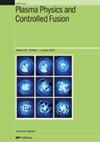QScatter:快速预测电子激光散射中粒子分布的数值框架
IF 2.3
2区 物理与天体物理
Q2 PHYSICS, FLUIDS & PLASMAS
引用次数: 0
摘要
新一代多 PetaWatt 激光设备将能够测试强场量子电动力学(QED),并为新型光子和轻子源提供机会。首批实验计划研究强聚焦激光脉冲与相对论电子束或高能光子源的(近)迎面散射。在这项工作中,我们提出了一个数值框架,可以快速预测散射后粒子和光子的渐近分布。本手稿中详述的方法可以包含多种特征,如激光和散射光束之间的空间和时间错位、宽带电子束和光束发散。通过结合分析描述和数值积分,可以计算出预期的平均能量、能量扩散、发散或其他观测值。这种方法可以在个人电脑上几分钟内得出结果,否则就需要使用数千个内核进行全尺寸三维 QED-PIC 模拟。该模型已编译成开源代码 QScatter,可用于支持对高重复率实验的大型数据集进行分析,利用其速度优化或重建实验参数。本文章由计算机程序翻译,如有差异,请以英文原文为准。
QScatter: numerical framework for fast prediction of particle distributions in electron-laser scattering
The new generation of multi-PetaWatt laser facilities will allow tests of strong field quantum electrodynamics (QED), as well as provide an opportunity for novel photon and lepton sources. The first experiments are planned to study the (nearly) head-on scattering of intense, focused laser pulses with either relativistic electron beams or high-energy photon sources. In this work, we present a numerical framework that can provide fast predictions of the asymptotic particle and photon distributions after the scattering. The method detailed in this manuscript can include multiple features such as spatial and temporal misalignment between the laser and the scattering beam, broadband electron beams, and beam divergence. The expected mean energy, energy spread, divergence or other observables are calculated by combining an analytical description and numerical integration. This method can provide results within minutes on a personal computer, which would otherwise require full-scale 3D QED-PIC simulations using thousands of cores. The model, which has been compiled into an open-source code QScatter , may be used to support the analysis of large-size data sets from high-repetition rate experiments, leveraging its speed for optimization or reconstruction of experimental parameters.
求助全文
通过发布文献求助,成功后即可免费获取论文全文。
去求助
来源期刊

Plasma Physics and Controlled Fusion
物理-物理:核物理
CiteScore
4.50
自引率
13.60%
发文量
224
审稿时长
4.5 months
期刊介绍:
Plasma Physics and Controlled Fusion covers all aspects of the physics of hot, highly ionised plasmas. This includes results of current experimental and theoretical research on all aspects of the physics of high-temperature plasmas and of controlled nuclear fusion, including the basic phenomena in highly-ionised gases in the laboratory, in the ionosphere and in space, in magnetic-confinement and inertial-confinement fusion as well as related diagnostic methods.
Papers with a technological emphasis, for example in such topics as plasma control, fusion technology and diagnostics, are welcomed when the plasma physics is an integral part of the paper or when the technology is unique to plasma applications or new to the field of plasma physics. Papers on dusty plasma physics are welcome when there is a clear relevance to fusion.
 求助内容:
求助内容: 应助结果提醒方式:
应助结果提醒方式:


